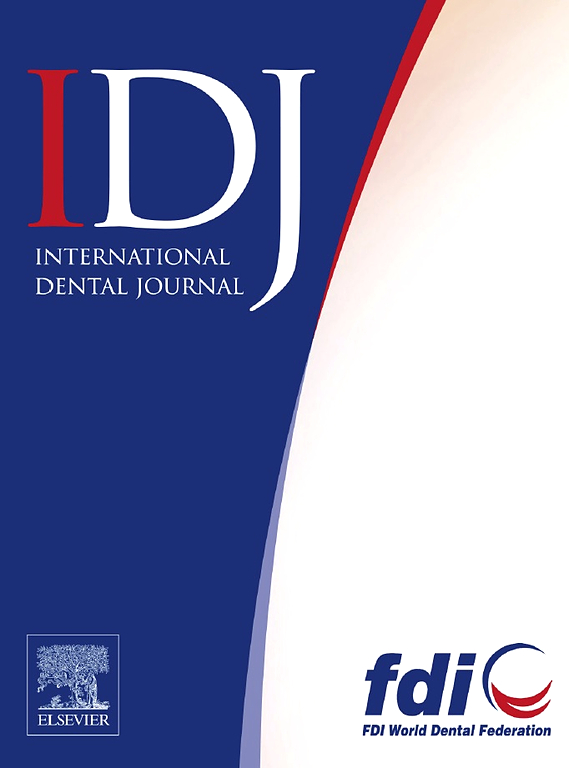在高发病率的菲律宾幼儿中验证龋齿风险评估工具。
IF 3.2
3区 医学
Q1 DENTISTRY, ORAL SURGERY & MEDICINE
引用次数: 0
摘要
引言和目的:龋齿风险评估是诊断过程中必不可少的一部分。许多研究都对这些工具进行了评估,证明在龋病发病率较低的发达国家,这些工具能有效降低未来的龋病风险。然而,在历次官方调查中,菲律宾儿童的龋齿患病率一直居高不下。这项前瞻性研究旨在比较现有的龋病风险评估工具在预测菲律宾龋病高发人群未来龋病方面的有效性:方法:从菲律宾卡洛坎市社区卫生中心的疫苗接种登记册中,根据修改后的国际龋病检测和评估系统(ICDAS)标准对 4-24 个月大的儿童进行口腔检查,并使用结构化问卷对他们的主要照顾者进行访谈。使用 3 种可用工具对基线龋齿风险类别进行评估,无需进行生物测试。2 年后的随访记录了龋齿发生率:703名幼儿(平均年龄:13.3个月,标准差(SD)2.4)的基线口腔检查结果显示,龋齿发病率高达29.2%。在 654 名基线时没有龋齿的合格儿童中,有 323 名(平均年龄:35.6 个月,标准差:5.1)参加了为期两年的随访,龋齿发生率(龋齿和非龋齿)为 76.5%。龋病风险评估表(CrAF)显示出较高的灵敏度,但特异性较低(93.1% 和 3.9%),而龋病风险评估管理(CAMBRA)显示出类似的模式(71.7% 和 34.2%)。相反,Cariogram 的灵敏度较低,但特异性较高(23.5% 和 80.3%):结论:在CrAF、CAMBRA或龋图中,没有任何一种评估工具(灵敏度+特异性<160)能够有效地识别出高龋患儿:当前的 CRA 工具在预测菲律宾儿童等高风险人群的龋病发展方面缺乏足够的准确性。完善或开发更有效的工具对于在个人和群体层面实施有效的龋病预防策略至关重要。本文章由计算机程序翻译,如有差异,请以英文原文为准。
Validating Caries Risk Assessment Tools in High-Prevalence Filipino Toddlers
Introduction and aims
Caries risk assessment is an essential part of the diagnostic process. Many studies have assessed these tools, proving their effectiveness in reducing future caries risk in developed countries with low caries prevalence. However, Filipino children have consistently registered high caries prevalence rates in successive official surveys. This prospective study aimed to compare the validity of available caries risk assessment tools in predicting future caries among a high-caries-prevalent population in the Philippines.
Methods
From the vaccination registry of community health centres in Caloocan City, Philippines, children aged 4–24 months underwent oral examinations according to modified International Caries Detection and Assessment System (ICDAS) criteria, and their primary caregivers were interviewed using a structured questionnaire. Baseline caries risk categories were evaluated using 3 available tools, without biological tests. Caries incidence was recorded during the follow-up visit after 2 years.
Results
Baseline oral examinations in 703 toddlers (mean age: 13.3 months, standard deviation (SD) 2.4) revealed a high caries prevalence of 29.2%. Of the 654 eligible children without cavitated caries at baseline, 323 (mean age: 35.6 months, SD 5.1) attended the 2-year follow-up visit, with a caries incidence (cavitated and non-cavitated) of 76.5%. Caries-risk Assessment Form (CrAF) demonstrated high sensitivity but low specificity scores (93.1% and 3.9%), while Caries Management by Risk Assessment (CAMBRA) showed similar patterns (71.7% and 34.2%). Conversely, Cariogram exhibited low sensitivity but high specificity (23.5% and 80.3%).
Conclusion
Among CrAF, CAMBRA or Cariogram, no assessment tool came close (sensitivity + specificity < 160) to effectively identify toddlers highly at risk of caries development.
Clinical Relevance
Current CRA tools lack sufficient accuracy in predicting caries development in high-risk populations like Filipino children. Refinement or development of more valid tools is crucial for implementing effective caries prevention strategies at both individual and population levels.
求助全文
通过发布文献求助,成功后即可免费获取论文全文。
去求助
来源期刊

International dental journal
医学-牙科与口腔外科
CiteScore
4.80
自引率
6.10%
发文量
159
审稿时长
63 days
期刊介绍:
The International Dental Journal features peer-reviewed, scientific articles relevant to international oral health issues, as well as practical, informative articles aimed at clinicians.
 求助内容:
求助内容: 应助结果提醒方式:
应助结果提醒方式:


